[Esp]Masajear y fortalecer el abdomen./[Eng]Massage and strengthen the abdomen.
Cuando se masajea el abdomen, al ejercitar el cuerpo, se fortalece su estructura muscular y la nerviosa, igualmente se protegen sus órganos internos, se activa el flujo sanguíneo en dicha zona y se contribuye a evitar la celulitis y el estreñimiento, repercutiendo favorablemente en la salud, en especial en las personas que sufren estrés y ansiedad, en ese orden de ideas, permitánme recomendar, una postura y su variante, que ofrecen, entre sus beneficios masajear y fortalecer el abdomen, me refiero a Janusirsasana o la postura de la cabeza a la rodilla y su variante con torsión, denominada Parivrtta Janusirsasana, con dichas asanas, cuando hacemos suaves movimientos abdominales también se estimula el flujo sanguíneo, nos aliviamos de los gases y mejoramos la digestión, por cuanto al estimularse el sistema digestivo, ayuda al colon a mover sin dificultad los residuos. El aumento de la sangre hacia la zona abdominal y el flujo de oxígeno, también representa otra de las importantes ventajas de dichas asanas, por cuanto al realizarse el masaje abdominal, se mejoran las funciones de los órganos internos, incluída la vesícula biliar y el hígado. Cuando notamos la ausencia de dolores abdominales, se fomenta un estado de relajación, siendo otro de los motivos para implementar como rutina las citadas asanas.
En ese orden de ideas,se reitera el desarrollo de Janusirsasana o la postura de la cabeza a la rodilla y su variante con torsión, denominada Parivrtta Janusirsasana, las cuales realizaremos sentados con la pierna izquierda doblada, cuya planta del pie apoyamos lateralmente en el muslo de la pierna derecha, la cual está extendida hacia delante, mientras estiramos el brazo izquierdo para tomar con la mano de ese lado el pie derecho, seguidamente flexionando el torso hacia la derecha, llevamos el brazo de dicho lado hacia atrás y doblando el codo, colocamos la mano en la nuca, además de contribuir a masajear y fortalecer los músculos abdominales, contribuyen a eliminar la grasa en dicha zona, expanden el pecho, mejoran las funciones de los órganos internos del abdomen, así como también los procesos circulatorios, digestivos y respiratorios, elongan los músculos del abdomen, de la espalda, los brazos y las piernas, asímismo, son muy relajante, calman la mente, alivian la ansiedad y la fatiga. Estimados, por los beneficios que ofrecen las mencionadas posturas, debemos desarrollarlas con frecuencia, para continuar sanándonos física y mentalmente. Éxitos.
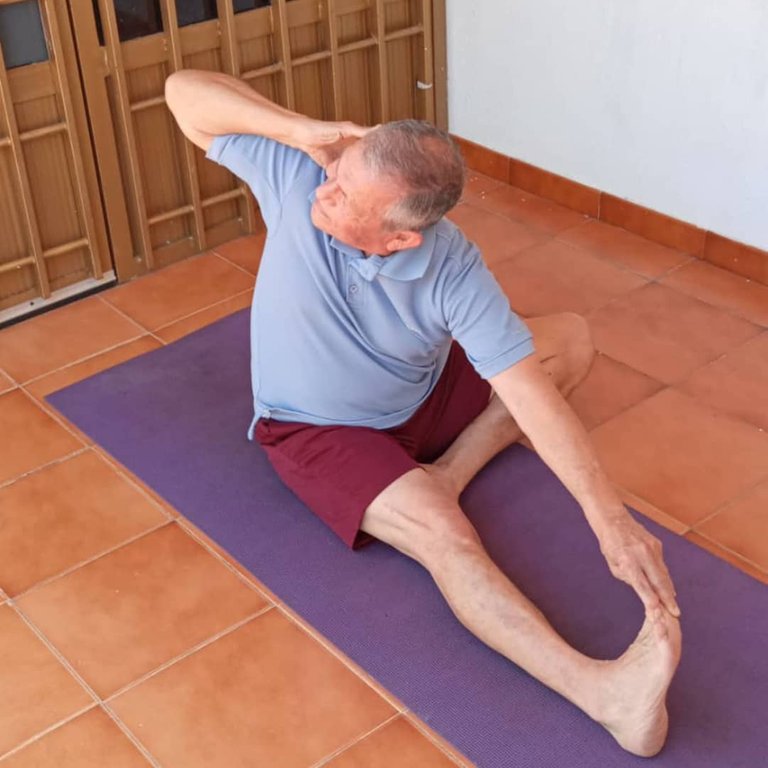
When the abdomen is massaged, when exercising the body, its muscular and nervous structure are strengthened, its internal organs are also protected, the blood flow in said area is activated and it helps to avoid cellulite and constipation, having a favorable effect on the health, especially in people who suffer from stress and anxiety, in that order of ideas, let me recommend a posture and its variant, which offer, among its benefits, massaging and strengthening the abdomen, I am referring to Janusirsasana or the posture of the head to the knee and its variant with torsion, called Parivrtta Janusirsasana, with these asanas, when we do gentle abdominal movements, blood flow is also stimulated, we relieve gas and improve digestion, because by stimulating the digestive system, it helps the colon to easily move the waste. The increase of blood to the abdominal area and the flow of oxygen, also represents another of the important advantages of these asanas, since when performing the abdominal massage, the functions of the internal organs are improved, including the gallbladder and the liver. When we notice the absence of abdominal pain, a state of relaxation is encouraged, being another reason to implement the aforementioned asanas as a routine.
In that order of ideas, reiterates the development of Janusirsasana or the head-to-knee posture and its variant with torsion, called Parivrtta Janusirsasana, which we will perform seated with the left leg bent, whose sole of the foot we support laterally on the thigh of the right leg, which is extended forward, while we stretch the left arm to take the right foot with the hand on that side, then bending the torso to the right, we bring the arm on that side backwards and bending the elbow, we place the hand on the back of the neck, In addition to helping to massage and strengthen the abdominal muscles, they help eliminate fat in that area, expand the chest, improve the functions of the internal organs of the abdomen, as well as the circulatory, digestive and respiratory processes, elongate the muscles of the abdomen, back, arms and legs, likewise, are very relaxing, calm the mind, relieve anxiety and fatigue. Dear friends, due to the benefits offered by the aforementioned postures, we must develop them frequently, to continue healing ourselves physically and mentally. Successes.
Proceso de Meditación
Meditamos, previamente al proceso de calentamiento corporal, para relajarnos y calmar la mente, lo haremos aplicando la siguiente postura; sentados con la espalda recta, las piernas dobladas delante del cuerpo, juntamos las plantas de los pies, extendemos los brazos al frente uniendo las palmas de las manos, para reflexionar e interanalizar los siguientes pensamientos:
1).-"El deber ser de las personas que han experimentado las mayores tristezas, es que ayuden más en hacer felices a los demás, por cuanto ellos saben lo que es sentirse desolados y abatidos y no quieren que nadie más se sienta así"
2).-"Tenemos que entender que hay amigos de trabajo, en los estudios, en las fiestas y amigos de verdad"
3.-"La paz mental comienza cuando tomamos la decisión de romper vínculos que no suman en la vida"
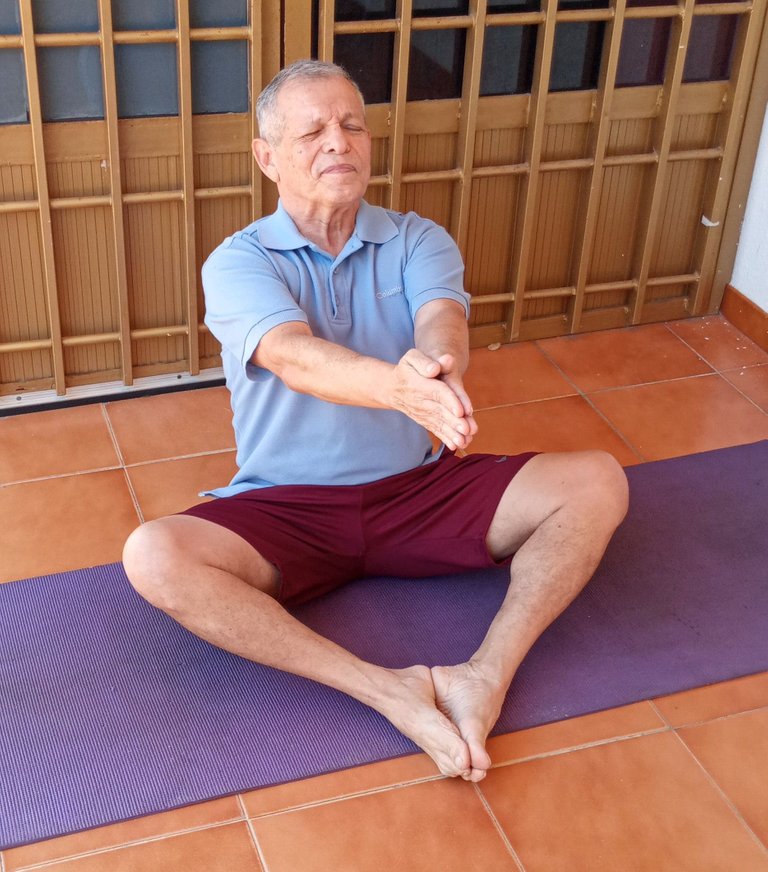
Meditation Process
We meditate, prior to the body warm-up process, to relax and calm the mind, we will do it by applying the following posture; Sitting with a straight back, legs bent in front of the body, we join the soles of the feet, we extend the arms in front joining the palms of the hands, to reflect and internalize the following thoughts:
1).-"The duty of the people who have experienced the greatest sadness is that they help more in making others happy, because they know what it is to feel desolate and despondent and they do not want anyone else to feel that way"
2).-"We have to understand that there are friends from work, in studies, at parties and real friends"
3.-"Peace of mind begins when we make the decision to break ties that do not add up in life"
Ejercicios para el calentamiento corporal
Con el propósito de lograr un efectivo rendimiento, evitar lesiones, flexibilizar los músculos y articulaciones, calentaremos el cuerpo, durante 12 minutos, descansando 10 segundos por cada dos minutos de ellos, al ejercitarnos previamente, ayudamos a equilibrar el cuerpo e iniciar con el fortalecimiento de los músculos de la espalda, del abdomen, los brazos y las piernas, en ese sentido los cumpliremos de la siguiente manera:
Estando en sentadillas, con el torso hacia delante, las rodillas flexionadas, los brazos con los codos doblados, las manos a los lados del rostro, estiramos los brazos y apoyamos las manos en las rodillas, luego entrecruzamos los brazos, colocando cada mano en la rodilla, manteniéndonos equilibrados.
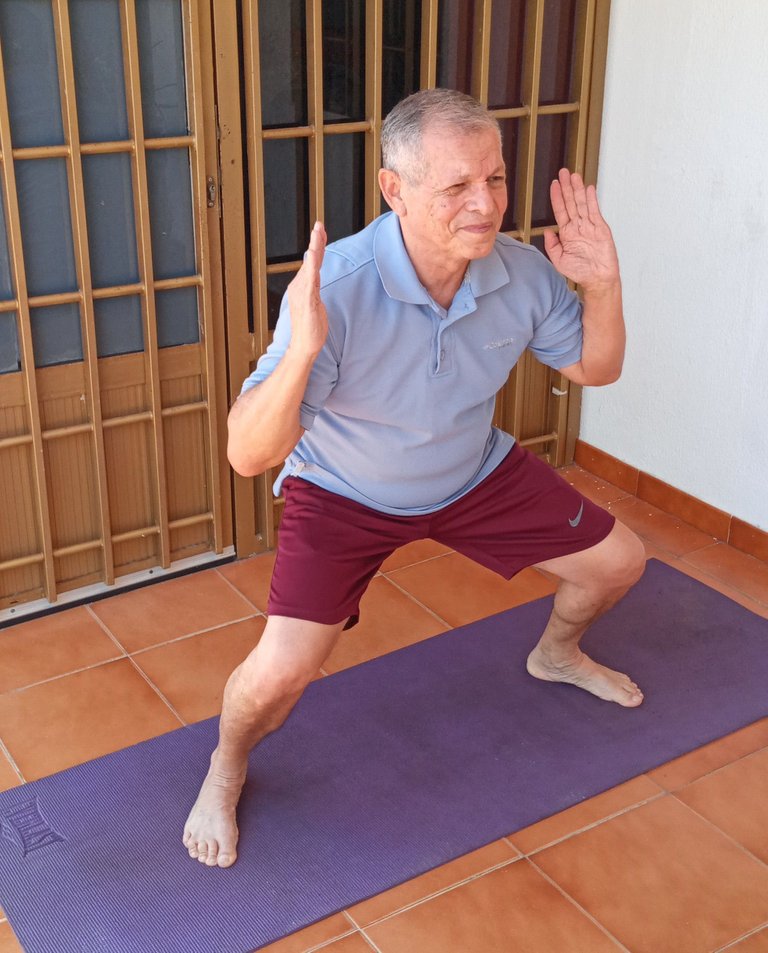
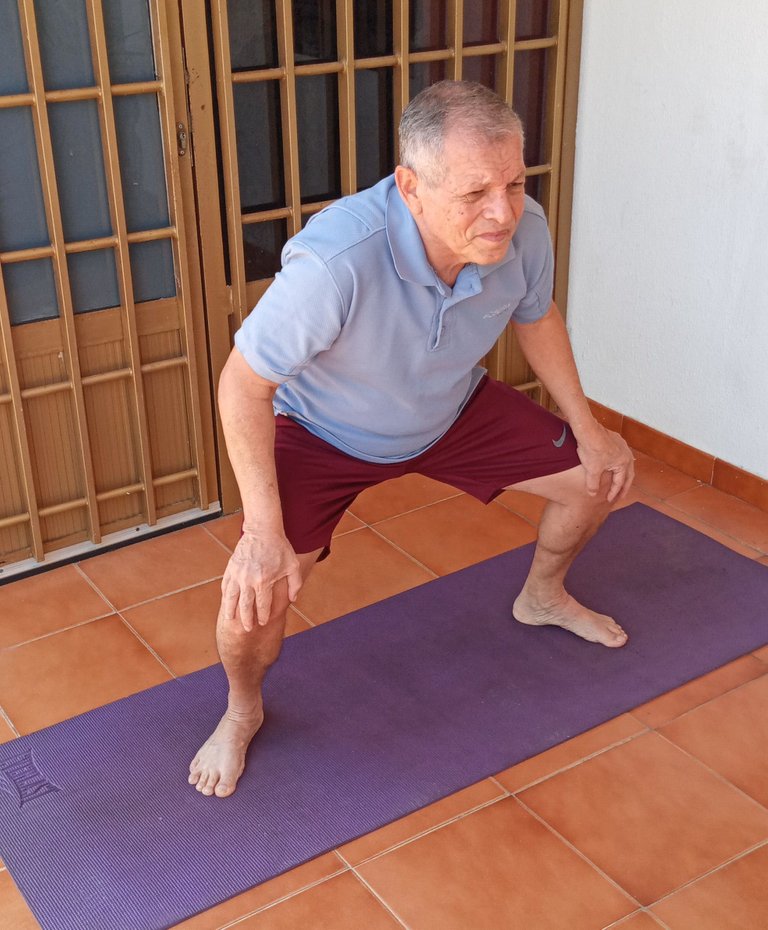
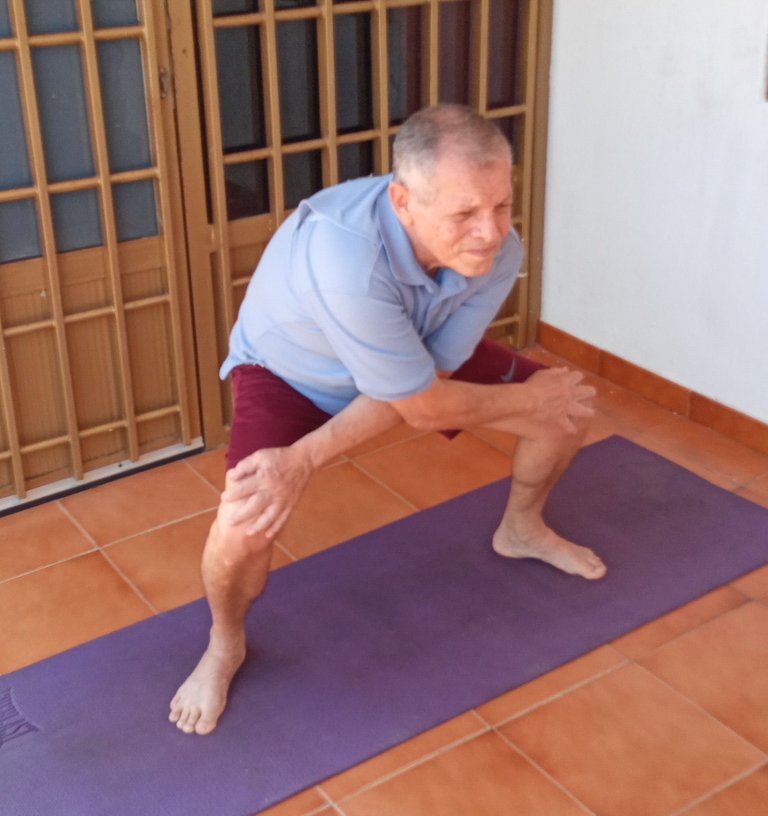
Exercises for body warm-up
In order to achieve effective performance, avoid injuries, make muscles and joints more flexible, we will warm up the body for 12 minutes, resting 10 seconds for every two minutes of them, by exercising previously, we help balance the body and start with strengthening of the muscles of the back, abdomen, arms and legs, in that sense we will fulfill them in the following way:
Being in squats, with the torso forward, the knees bent, the arms with the elbows bent, the hands at the sides of the face, we stretch the arms and rest the hands on the knees, then we cross the arms, placing each hand on the knee, keeping us balanced.
Estando en la posición anterior, con las piernas flexionadas y los brazos entrecruzados, despegamos cada mano de la rodilla contraria, procediendo a apoyarlas en la esterilla, una vez que bajemos el torso suavemente, sin hacer mucha tensión para posteriormente colocar cada una de ellas delante de cada pie, luego extendiendo los brazos hacia atrás, reposamos cada mano, hacia el lado de afuera de de ellos. Manteniéndonos muy equilibrados y en resistencia corporal, realizando las respiraciones correspondientes.
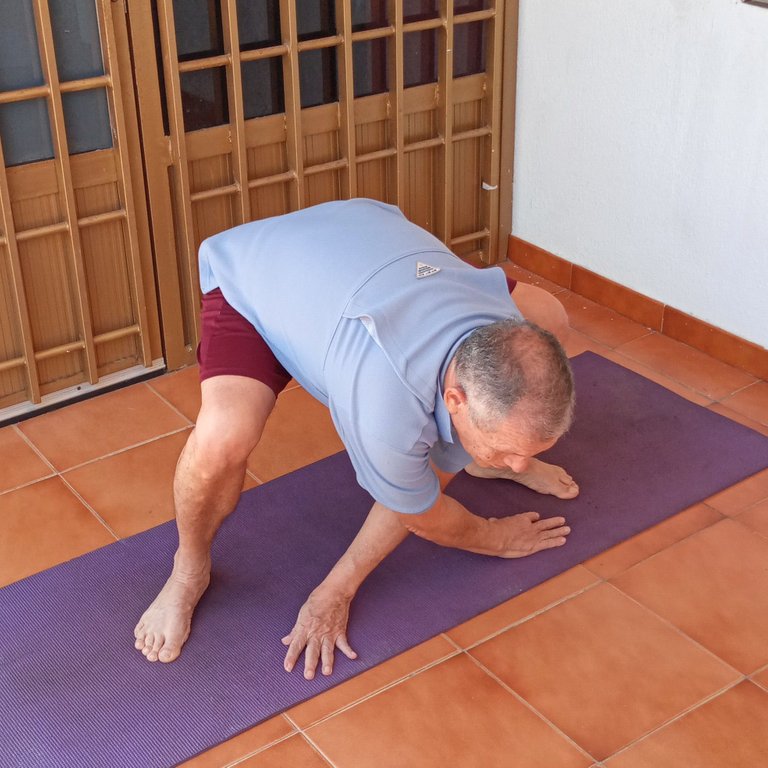
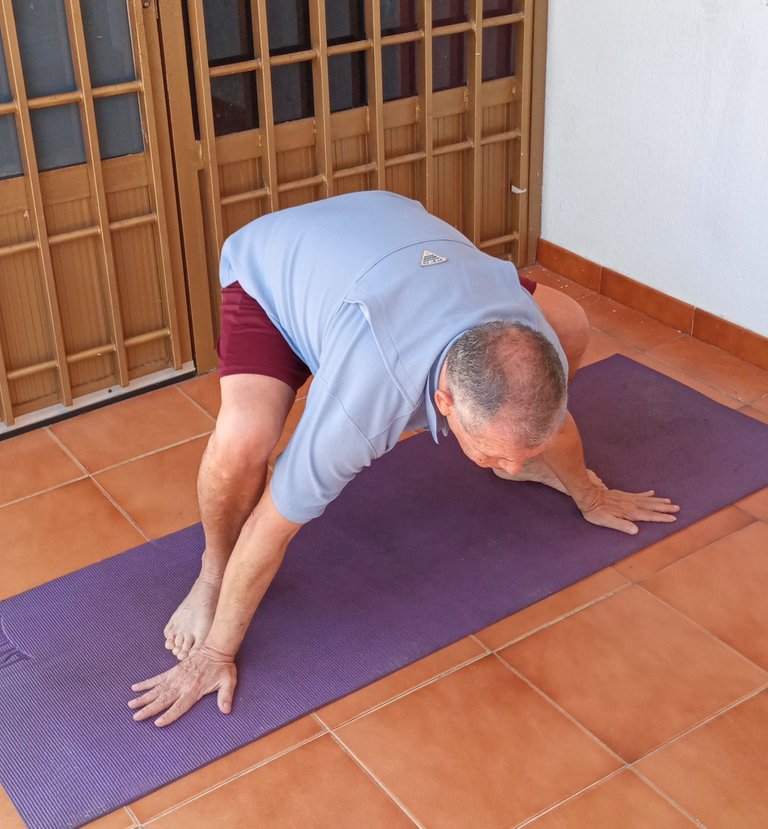

Being in the previous position, with the legs bent and the arms crossed, we take each hand off the opposite knee, proceeding to support them on the mat, once we gently lower the torso, without making much tension to later place each of them in front of each foot, then extending the arms backwards, we rest each hand, towards the outside of them. Keeping ourselves very balanced and in body resistance, performing the corresponding breaths.
Ubicados en sentadillas, despegamos las manos de la esterilla, levantamos los brazos, para apoyar en la nuca, las manos con los dedos entrelazados, luego flexionamos el torso hacia la izquierda, direccionando el brazo izquierdo doblado a la rodilla de la pierna izquierda, repitiendo dichas acciones hacia el lado derecho, es decir con el torso y brazo derecho a la derecha. Éxitos.
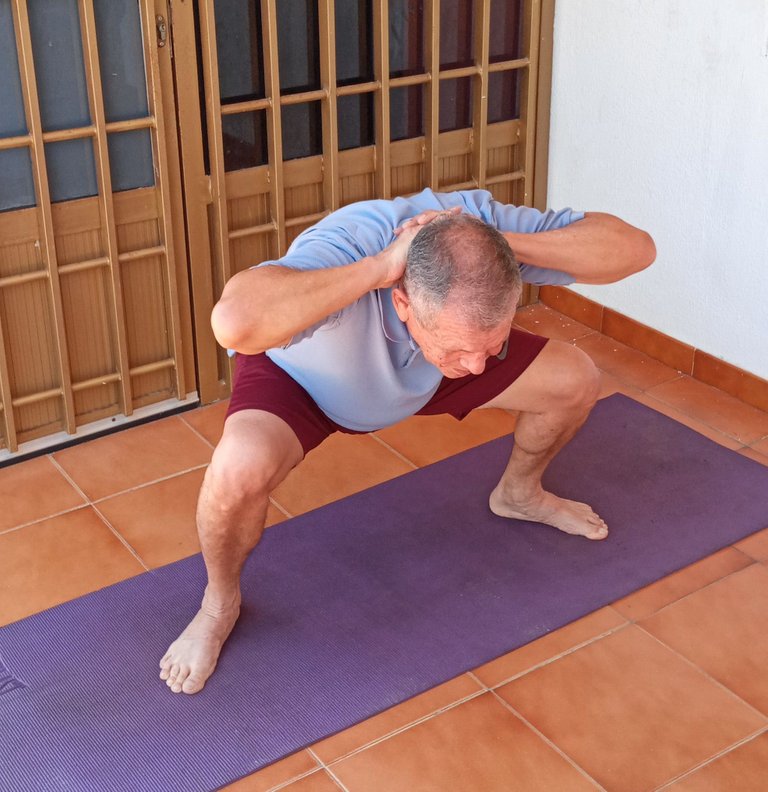

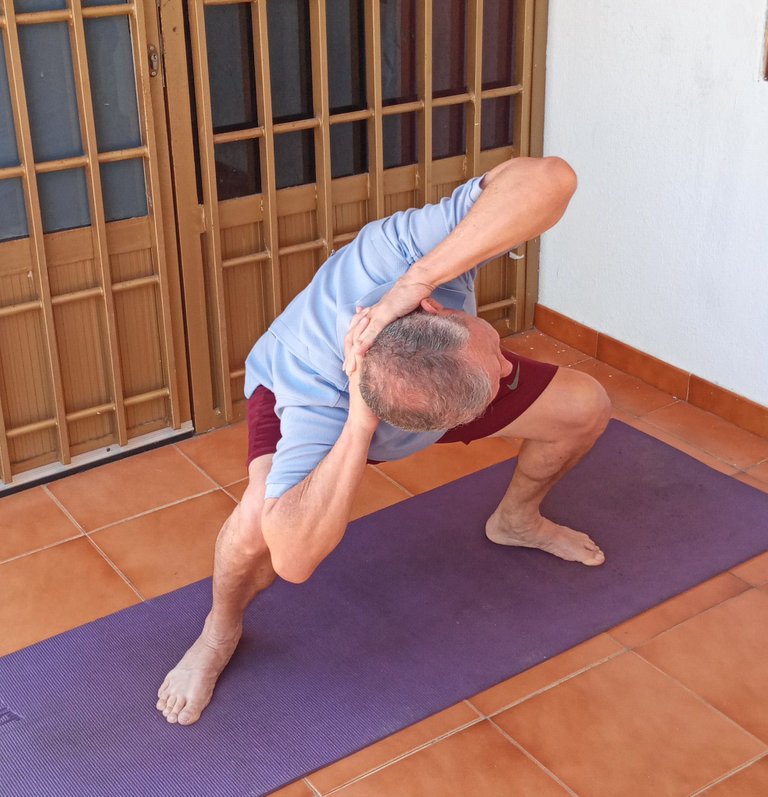
Located in squats, we take our hands off the mat, raise our arms, to rest on the neck, hands with fingers intertwined, then flex the torso to the left, directing the bent left arm to the knee of the left leg, repeating said actions towards the right side, that is to say with the torso and right arm to the right. Successes.
Desarrollo de Janusirsasana o la postura de la cabeza a la rodilla y su variante con torsión, denominada Parivrtta Janusirsasana, las cuales realizaremos sentados con la pierna izquierda doblada, cuya planta del pie apoyamos lateralmente en el muslo de la pierna derecha, la cual está extendida hacia delante, mientras estiramos el brazo izquierdo para tomar con la mano de ese lado el pie derecho, seguidamente flexionando el torso hacia la derecha, llevamos el brazo de dicho lado hacia atrás y doblando el codo, colocamos la mano en la nuca
Estando en Dandasana o la postura el bastón, sentados con la espalda derecha, los brazos y las manos a los lados del torso, las piernas estiradas hacia delante, procedemos a doblar la pierna izquierda apoyando la planta del pie izquierdo en la lateral del muslo de la pierna derecha la cual queda extendida, sin hacer mucha tensión de la columna, hasta donde lo permita la flexibilidad corporal, llevamos el torso hacia delante y despegando las manos de la esterilla, tomamos los dedos de los pies, si no se puede, recordemos que el yoga es para sanarnos, en tal sentido es suficiente apuntar con los dedos de las manos, hacia el pie derecho, conformando la postura Janusirsasana o de la cabeza a la rodilla, equilibrados y en resistencia corporal, inspiramos, aguantamos y expulsamos aire. Éxitos.
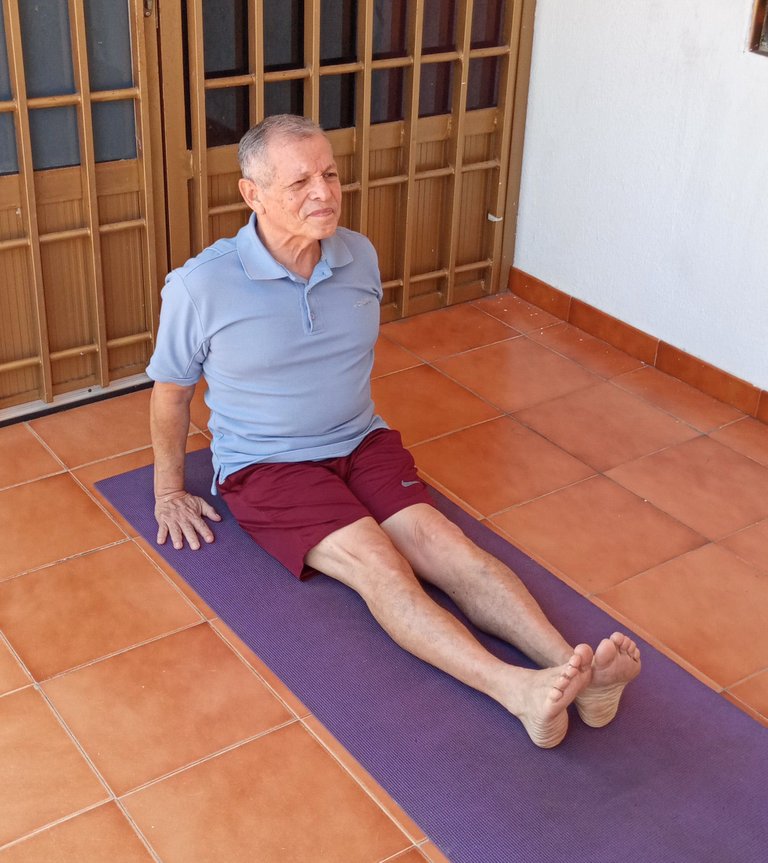
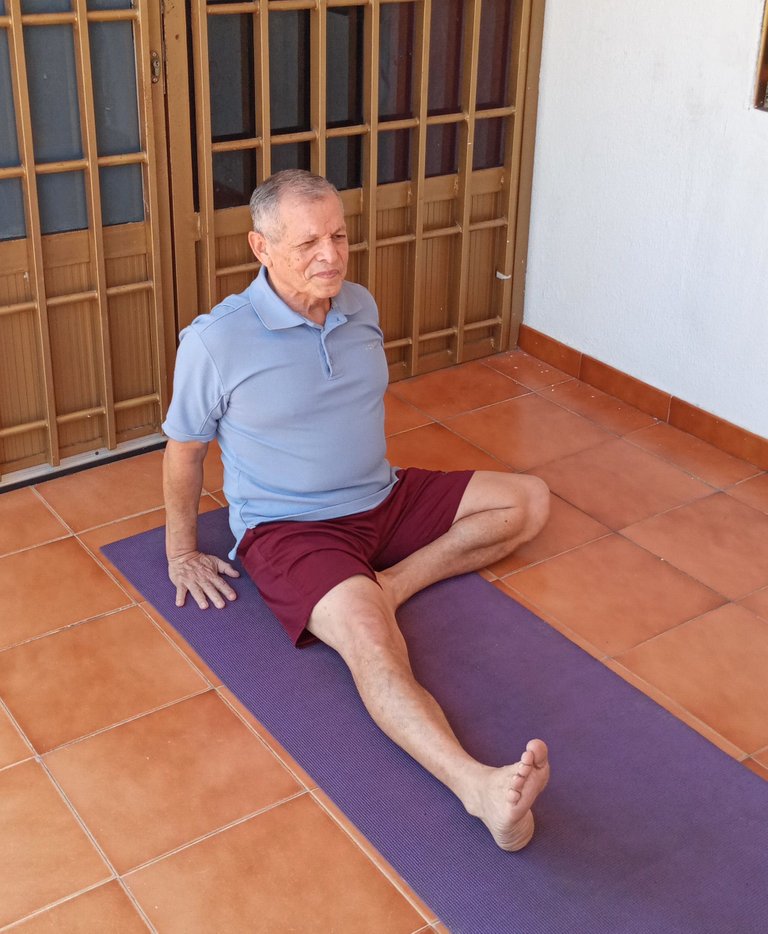

Development of Janusirsasana or the head-to-knee posture and its variant with torsion, called Parivrtta Janusirsasana, which we will perform sitting with the left leg bent, whose sole is supported laterally on the thigh of the right leg, which is extended forward, while stretching the left arm to grab the right foot with the hand on that side, then bending the torso to the right, bring the arm on that side backwards and bending the elbow, place the hand on the back of the neck
Being in Dandasana or the posture of the staff, sitting with the back straight, arms and hands at the sides of the torso, legs stretched out in front, we proceed to bend the left leg, supporting the sole of the left foot on the side of the thigh. the right leg which remains extended, without exerting much tension on the spine, as far as body flexibility allows it, we take the torso forward and taking off the hands from the mat, we take the toes, if it is not possible, remember that yoga is to heal us, in this sense it is enough to point with the fingers of the hands, towards the right foot, forming the Janusirsasana posture or from the head to the knee, balanced and in body resistance, we breathe in, hold and expel air. Successes.
Ubicados en Janusirsasana o la postura de la cabeza a la rodilla, es decir en la posición anterior, con la pierna izquierda doblada, manteniendo la pierna derecha extendida, dejando la mano izquierda apuntando hacia el pie derecho, sin hacer mucha tensión de la cintura, suavemente giramos el torso a la derecha, despegamos la mano del citado lado, llevando el brazo derecho estirado hacia atrás, equilibrados y en resistencia corporal, inspiramos, aguantamos y expulsamos aire. Éxitos.
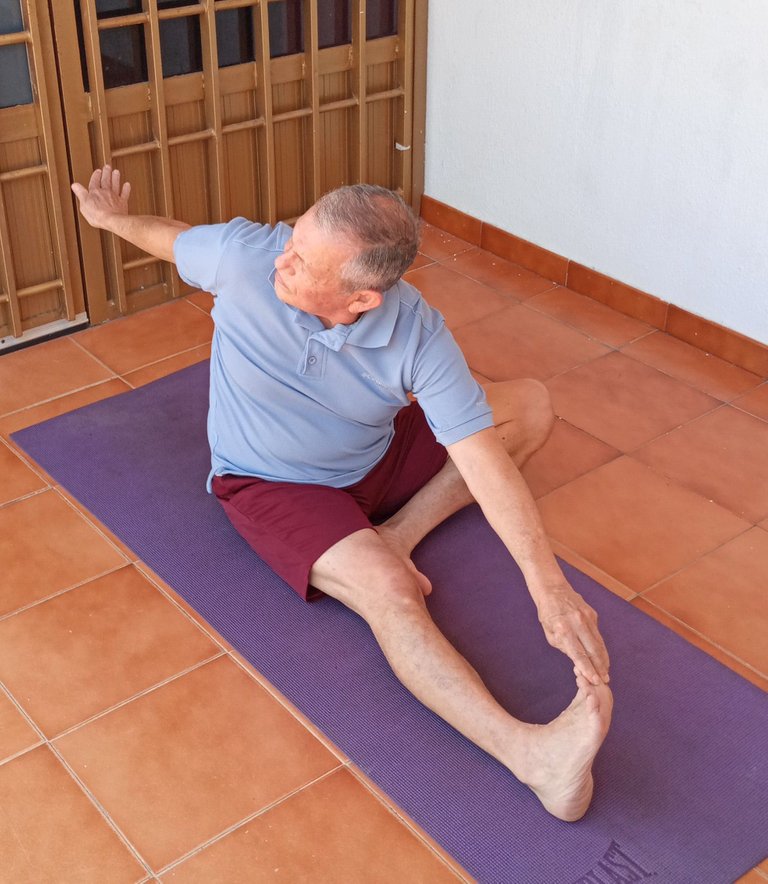
Located in Janusirsasana or the posture of the head to the knee, that is to say in the previous position, with the left leg bent, keeping the right leg extended, leaving the left hand pointing towards the right foot, without making much tension from the waist, we gently turn the torso to the right, we take off the hand of the mentioned side, taking the right arm stretched backwards, balanced and in body resistance, we inspire, hold and expel air. Successes.
Conformamos la variante Parivrtta Janusirsasana o de la cabeza a la rodilla con el torso girado, estando en la postura anterior, es decir con la pierna izquierda flexionada, la pierna derecha extendida hacia delante, la mano izquierda hacia el pie derecho, con el torso girado a la derecha, doblamos el codo del brazo derecho que se encuentra atrás del cuerpo, colocando la mano derecha en la nuca, durando 30 segundos equilibrados equilibrados y en resistencia corporal, inspirando, aguantando y expulsando aire. Éxitos.
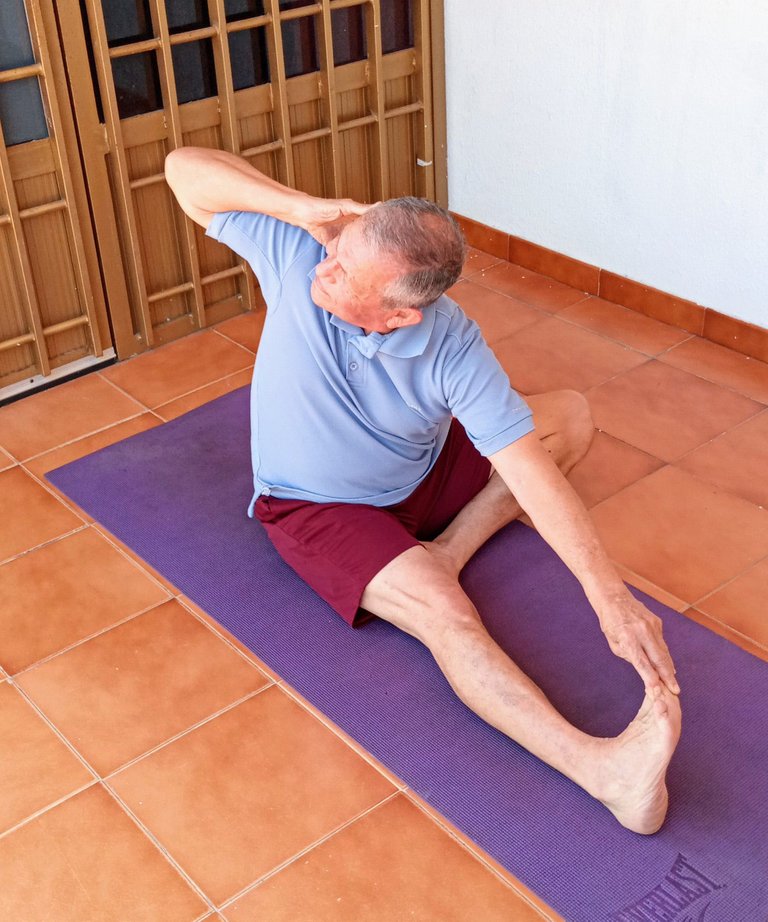
We form the Parivrtta Janusirsasana variant or from head to knee with the torso rotated, being in the previous position, that is, with the left leg bent, the right leg extended forward, the left hand towards the right foot, with the torso rotated to the right, we bend the elbow of the right arm that is behind the body, placing the right hand on the neck, lasting 30 seconds balanced balanced and in body resistance, inhaling, holding and expelling air. Successes.
Repetimos la variante Parivrtta Janusirsasana o de la cabeza a la rodilla con el torso girado, estando desde la posición inicial, es decir Dandasana o el bastón, en esta ocasión procediendo a flexionar la pierna derecha y la pierna izquierda extendida hacia delante, con las manos hacia dicho pie, conformamos Janusirsasana, luego con el torso girado a la izquierda, doblamos el codo del brazo izquierdo que se encuentra atrás del cuerpo, colocando la mano izquierda en la nuca, durando 30 segundos equilibrados equilibrados y en resistencia corporal, inspirando, aguantando y expulsando aire. Éxitos.

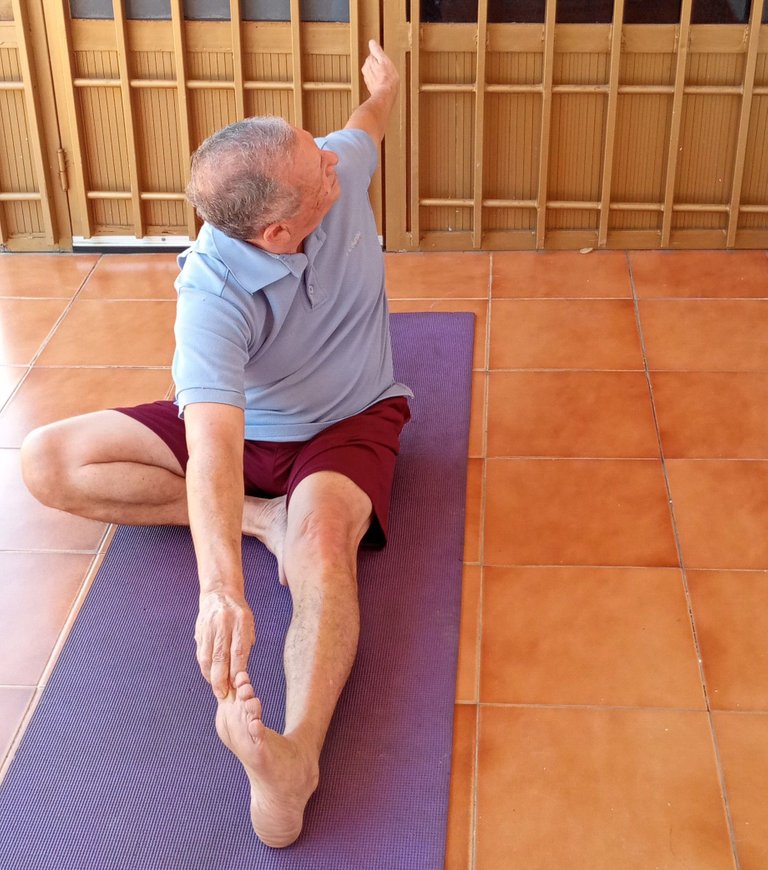
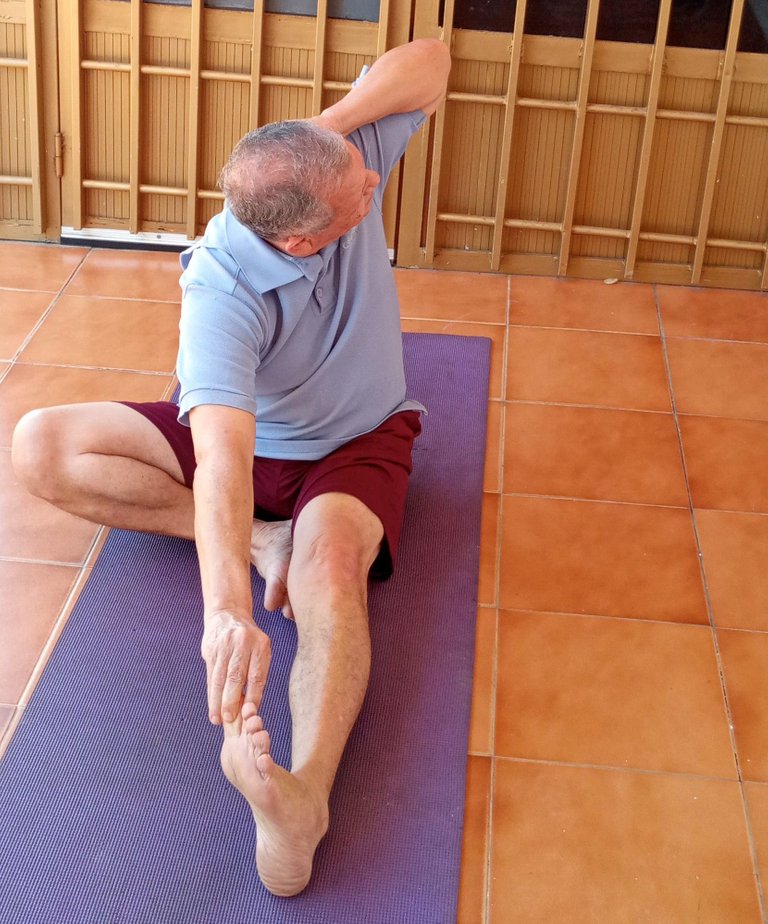
We repeat the Parivrtta Janusirsasana variant or from the head to the knee with the torso rotated, being from the initial position, that is, Dandasana or the staff, this time proceeding to flex the right leg and the left leg extended forward, with the hands towards said foot, we form Janusirsasana, then with the torso turned to the left, we bend the elbow of the left arm that is behind the body, placing the left hand on the back of the neck, lasting 30 seconds balanced balanced and in body resistance, inhaling, holding and expelling air. Successes.
Beneficios de la postura Janusirsasana o la postura de la cabeza a la rodilla y su variante con torsión, denominada Parivrtta Janusirsasana, sentados con una pierna doblada, una mano apuntando a la pierna extendida, girando el torso, mientras el otro brazo está doblado atrás con la mano en la nuca
- Son excelentes posturas, que contribuyen a masajear y fortalecer los músculos abdominales.
- Ayudan a eliminar la grasa abdominal.
- Permiten expandir el pecho.
- Son asanas que mejoran las funciones de los órganos internos del abdomen.
- Son buenas para el efectivo cumplimiento de los procesos, circulatorios digestivos y respiratorios.
- Ayudan a elongan los músculos del abdomen, de la espalda, los brazos y las piernas.
- Son posturas muy relajantes.
- Contribuyen a calmar la mente, aliviar la ansiedad y la fatiga.
Benefits of Janusirsasana or Head to Knee Pose and its twisted variation, called Parivrtta Janusirsasana, sitting with one leg bent, one hand pointing to the extended leg, twisting the torso, while the other arm is bent back with the hand on the neck
- They are excellent postures, which help to massage and strengthen the abdominal muscles.
- Help to eliminate abdominal fat.
- Allow to expand the chest.
- They are asanas that improve the functions of the internal organs of the abdomen.
- They are good for the effective fulfillment of the processes, circulatory, digestive and respiratory.
- Help stretch the muscles of the abdomen, back, arms and legs.
- They are very relaxing postures.
- Contribute to calm the mind, relieve anxiety and fatigue.
Janusirsasana o la postura de la cabeza a la rodilla y su variante con torsión, denominada Parivrtta Janusirsasana, sentados con una pierna doblada, una mano apuntando a la pierna extendida, girando el torso, mientras el otro brazo está doblado atrás con la mano en la nuca, son muy recomendadas por contribuir a masajear y fortalecer los músculos abdominales, asímismo son importantes desarrollarlas por su efectiva acción de eliminar la grasa abdominal, expandir el pecho y mejorar las funciones de los órganos internos del abdomen, así como también por ser muy efectivas para mejorar los procesos circulatorios, digestivos y respiratorios. Otros beneficios que debemos destacar, es que las citadas asanas permiten elongar los músculos del abdomen, de la espalda, los brazos y las piernas, ofreciendo una adecuada relajación, calmar la mente, aliviar la ansiedad y la fatiga, en ese sentido, cuando indiquemos un calendario para las prácticas de yoga, las referidas posturas, son las adecuadas para mejorar la salud. Amigos, al agradecerles su receptividad y continúas visitas, me suscribo a ustedes, con mucho afecto. Omar Gustavo Rojas Ortiz desde la ciudad de Cumaná en el estado Sucre-Venezuela.
Janusirsasana or Head to Knee Pose and its twisted variant, called Parivrtta Janusirsasana, sitting with one leg bent, one hand pointing to the extended leg, twisting the torso, while the other arm is bent behind with the hand on the neck, they are highly recommended for helping to massage and strengthen the abdominal muscles, they are also important to develop for their effective action to eliminate abdominal fat, expand the chest and improve the functions of the internal organs of the abdomen, as well as for being very effective to improve circulatory, digestive and respiratory processes. Other benefits that we must highlight is that the aforementioned asanas allow the muscles of the abdomen, back, arms and legs to be elongated, offering adequate relaxation, calming the mind, relieving anxiety and fatigue, in that sense, when we indicate a calendar for yoga practices, the aforementioned postures, are appropriate to improve health. Friends, in thanking you for your receptivity and continued visits, I subscribe to you, with great affection. Omar Gustavo Rojas Ortiz from the city of Cumaná in the state of Sucre-Venezuela.
Las imágenes fueron tomadas por Nancy de Rojas con mi celular Samsung Galaxy A10s y la publicación es de mi autoría.
The images were taken by Nancy de Rojas with my Samsung Galaxy A10s cell phone and the publication is my own.
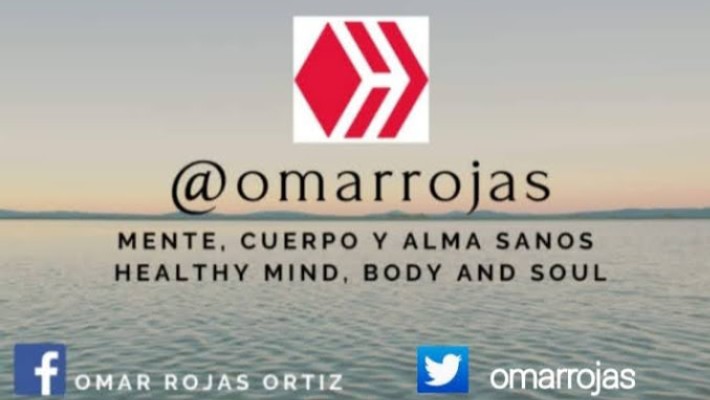
https://twitter.com/Omarroj52318483/status/1568577537705402370
https://twitter.com/metodologiaecs/status/1568578240536526850
The rewards earned on this comment will go directly to the people( @pedrobrito2004 ) sharing the post on Twitter as long as they are registered with @poshtoken. Sign up at https://hiveposh.com.
Muy buen articulo: excelente explicación y las fotos muy adecuadas para entrar de forma correcta al asana. Felicidades y gracias por compartir
Gracias por su opinión, lo cual me alegra mucho. La presentación asana es muy importante para fortalecer el abdomen y reducir grasa abdominal, con constancia se logra. Le deso muchos éxitos a usted.
Señor @omarrojas hola. Gusto en saludarlo. Me encantaron todas esas posturas o asanas están genial. comenzaré a practicarlas nuevamente. Saludos
Gracias a usted. Las presentes posturas son muy buenas para reducir grasa abdominal y fortalecer el abdomen, con una suave dedicación diaria es muy efectiva.
Como siempre otra buena rutina, se ve muy relajante esos estiramiento que ayudan a reafirmar el cuerpo.
Gracias estimada amiga, sus palabras son muy motivantes, espero que también me acompañen a desarrollar los referidos ejercicios, para siempre estar en forma. Cuando nuestros músculos están fortalecidos, los días son más agradables. Saludos. Éxitos.
!PGM Reblogged
Thank you, your words are very motivating. I wish you success
Reblogged for being awesome !PGM
Thank you, your words are very motivating. I wish you success
Reblogged for being awesome !PGM
Thank you, your words are very motivating. I wish you success
!PGM Reblogged cause you are awesome, has anyone told you that today?
I am very grateful for the positive opinion you offer of my publication, which motivates me. I hope to continue counting on your beautiful appreciations and continued visits. Successes